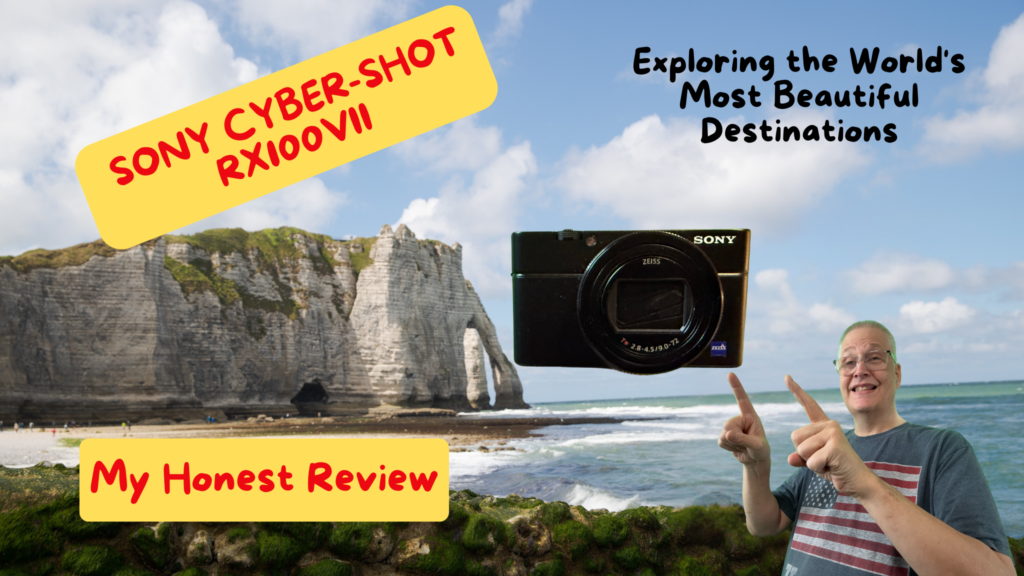Bryce Canyon National Park Review
Visiting Bryce Canyon National Park was a remarkable experience filled with stunning landscapes and unique rock formations. Its vibrant hoodoos and striking vistas make it a must-see destination for nature lovers and photographers alike. The park, established in 1928, is a testament to the beauty of natural erosion and offers numerous activities that cater to various interests.

As I explored the hiking trails, each step revealed breathtaking views and the rich ecology of the area. From the iconic Navajo Loop Trail to the peaceful Bristlecone Loop, there was always something new to admire. My visit included ample opportunities for photography, allowing me to capture the park’s changing light and colors throughout the day.
Whether you’re an avid hiker or simply looking to enjoy stunning scenery, Bryce Canyon offers something for everyone. As I reflect on my journey, I can’t help but encourage fellow travelers to experience this natural wonder for themselves.
Things to do at Bryce Canyon
- Bryce Canyon’s hoodoos create a stunning and unique landscape.
- The park offers trails for all skill levels, from easy walks to strenuous hikes.
- Sunrise and sunset at Bryce Amphitheater provide breathtaking photo opportunities.
- A scenic drive with multiple viewpoints allows visitors to experience the park without extensive hiking.
- Bryce Canyon is a top destination for stargazing, thanks to its dark skies and high elevation.
- The park is beautiful year-round, with each season offering a unique experience.
- Wildlife sightings are common, including deer, prairie dogs, and a variety of birds.
- Camping and lodging options are available inside and near the park for different budgets.
- Weather can change quickly, so dressing in layers is recommended.
- Shuttle services run during peak seasons, making park access easier and reducing congestion.
History and Significance of Bryce Canyon
Bryce Canyon has a rich history marked by its unique geological features and its journey to becoming a national park. I find it fascinating how this area has evolved, both naturally and through human influence.
Geological Formation
Bryce Canyon is renowned for its striking hoodoos, which are tall, thin spires of rock that rise dramatically from the canyon floor. These fascinating formations have been sculpted over millions of years through a combination of erosion, frost-wedging, and the persistent forces of wind and water. Unlike traditional canyons, which are typically carved by rivers, Bryce Canyon’s unique landscape resulted from the uplift of the Colorado Plateau, followed by weathering and the gradual breakdown of its sedimentary rock layers.
The primary rock type in the canyon is limestone, which plays a key role in shaping its formations. Rich in iron oxides and other minerals, the rock displays a striking palette of deep reds, burnt oranges, bright whites, and soft pinks that shift with the changing light throughout the day. These vivid hues are not just visually stunning but also serve as a geological record, revealing insights into ancient climates, water levels, and the mineral compositions that shaped the landscape over time.
One of the most significant factors in hoodoo formation is frost-wedging. Due to Bryce Canyon’s high elevation, which exceeds 8,000 feet, the area experiences frequent freeze-thaw cycles. Water seeps into the cracks of the rock during the day, then freezes and expands at night, gradually breaking apart the stone. This process repeats thousands of times each year, slowly sculpting the spires, fins, and towering rock formations seen today. In addition to frost-wedging, rain and wind further contribute to erosion, forming Bryce Canyon’s famous amphitheaters. The most well-known of these is Bryce Amphitheater, home to some of the park’s most iconic viewpoints, including Sunrise Point, Sunset Point, Inspiration Point, and Bryce Point.
Standing at these overlooks, I am mesmerized by the vast expanse of hoodoos stretching endlessly across the horizon. Their intricate formations and towering presence make Bryce Canyon feel almost otherworldly, as if frozen in time. Beyond their beauty, these rock formations tell a deeper story of the Earth’s dynamic history, chronicling shifts in climate, ancient sea levels, and the relentless power of nature that continues to shape this landscape.
Whether observed at sunrise, when the canyon glows with fiery orange hues, or under a starlit sky, where Bryce Canyon’s remote location makes it one of the best stargazing destinations in the world, this park never fails to leave a lasting impression. Every visit offers something new, and every formation tells a story waiting to be discovered by those who take the time to explore.
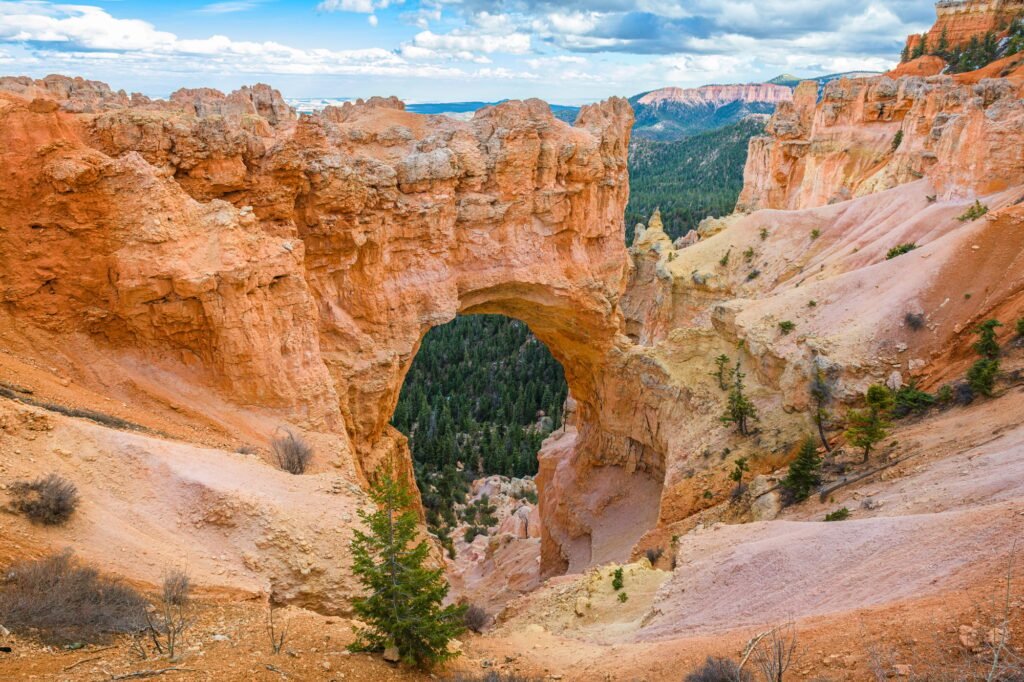
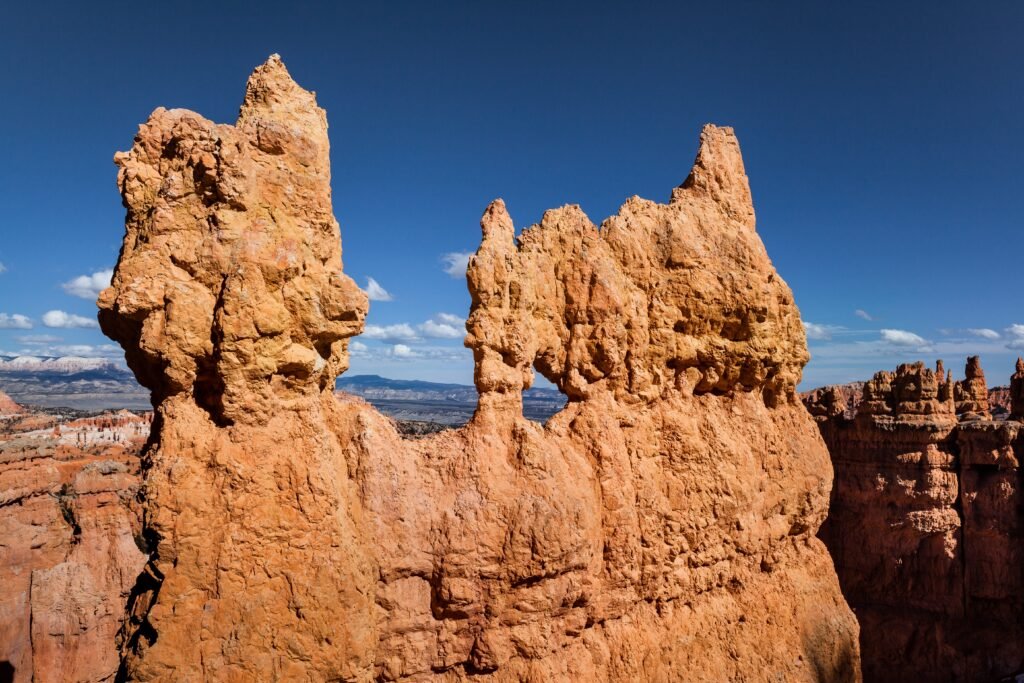

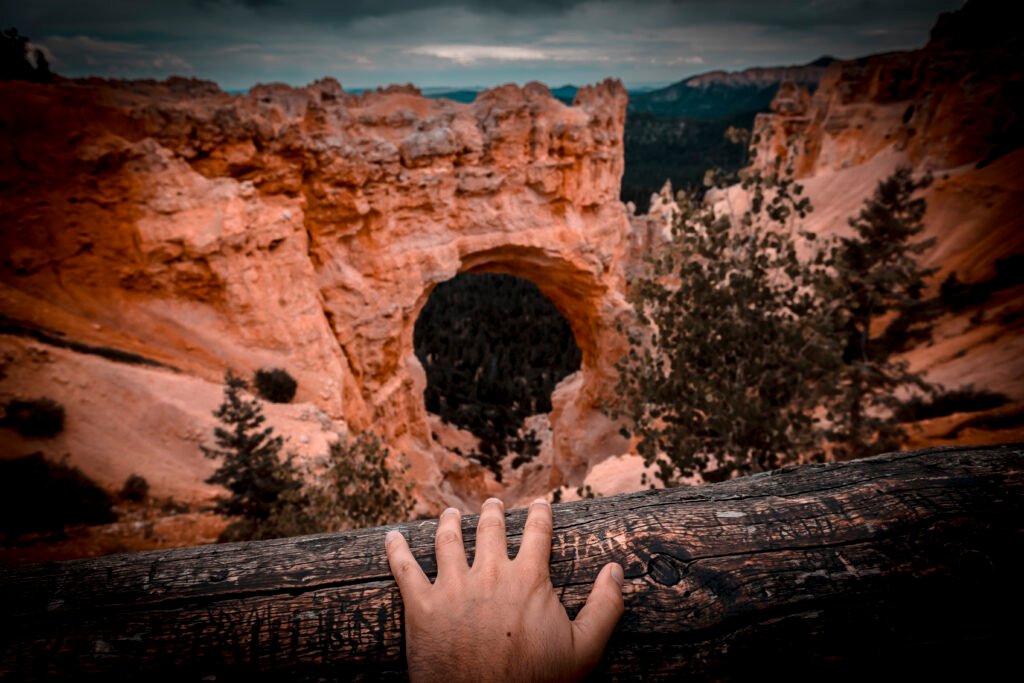
Discovery and National Park Designation
The history of Bryce Canyon’s discovery dates back to the 1850s when Mormon pioneers explored the area. These early settlers recognized its beauty but did not fully understand its significance until later.
The area was first designated a national monument in 1923 and then officially became Bryce Canyon National Park on February 25, 1928, under President Calvin Coolidge. This designation helped protect the landscape from development and encouraged conservation efforts.
The establishment of the park helped promote tourism, drawing nature lovers and outdoor enthusiasts from across the country. Today, Bryce Canyon National Park stands as a testament to the natural beauty and rich history that I cherish and respect.
Exploring Bryce Canyon Landscapes
Bryce Canyon National Park offers breathtaking landscapes characterized by unique geological features and diverse ecosystems. I found the mix of hoodoos, rock formations, and stunning viewpoints to be a highlight of my visit.
Majestic Hoodoos and Rock Formations
The hoodoos are the park’s most famous features, rising like towering stone sculptures from the canyon floor. These tall, thin spires of rock have been shaped over thousands of years through a slow but powerful process of erosion and weathering. Water, wind, and ice have all played a role in carving these formations, creating an otherworldly landscape that feels almost surreal. Some hoodoos stand alone, while others cluster together, forming intricate patterns that change in appearance depending on the angle of the sunlight.
As I walked along the trails, I was in awe of their varying shapes and sizes. Some hoodoos are slender and needle-like, while others have wider, sculpted tops, resembling frozen towers or figures frozen in time. Each hoodoo has its own distinct character, with colors ranging from soft pinks and bright oranges to deep reddish hues. The way the light dances across their surfaces during sunrise and sunset makes them even more mesmerizing, as shadows shift and highlight their rugged textures.
The formations are best viewed from different points along the rim, each offering a unique perspective on the canyon’s beauty. One of my favorite spots was Inspiration Point, where I could take in an expansive view of hoodoos stretching endlessly into the distance. The towering spires looked like an ancient city of stone, standing resilient against the elements. Bryce Point and Sunrise Point also provided breathtaking views, especially in the early morning when the landscape seemed to glow with fiery colors.
Beyond the hoodoos, other remarkable rock formations showcase the park’s fascinating geology. The Natural Bridge, a massive arch carved from red rock, is a striking example of nature’s ability to sculpt stone over time. Overlooking this incredible feature, I couldn’t help but feel a sense of wonder at how the forces of nature have shaped and reshaped Bryce Canyon for millions of years. Each formation tells a silent story of transformation, making every visit to the park a journey through time and natural artistry.
Discovery and National Park Designation
Bryce Canyon is home to several iconic overlooks that offer breathtaking views of its vast and rugged landscapes. Each vantage point provides a unique perspective, allowing visitors to fully appreciate the intricate beauty of the canyon’s towering hoodoos, deep amphitheaters, and expansive plateaus. Whether catching the first light of dawn or watching the sun dip below the horizon, these viewpoints showcase the park’s ever-changing colors and dramatic rock formations.
One of the most awe-inspiring overlooks is Rainbow Point, the highest point in the park at an impressive 9,115 feet above sea level. From here, I could see a panoramic view of the entire canyon, stretching out endlessly in shades of red, orange, and white. The elevation provides a sweeping perspective of Bryce’s natural amphitheaters, as well as distant forests and plateaus beyond the park’s borders. The colors of the canyon seem to shift throughout the day, with the morning sun casting a golden glow and the evening light deepening the reds and oranges. Standing at Rainbow Point, I felt a profound sense of wonder, as if I were gazing at an ancient landscape frozen in time.
Another favorite stop was Bryce Point, one of the most famous overlooks in the park. This viewpoint is renowned for its spectacular views of Bryce Amphitheater, home to the highest concentration of hoodoos in the world. As I stood at the edge, I was mesmerized by the jagged spires stretching into the distance, creating a maze-like formation that looked almost otherworldly. It’s no surprise that Bryce Point is one of the best places for photography, especially during sunrise, when the first rays of sunlight bathe the hoodoos in brilliant shades of orange, pink, and red. The contrast between the glowing rocks and the deep shadows cast by the towering formations made for an unforgettable sight.
Beyond these two overlooks, each viewpoint in Bryce Canyon offers a different and equally rewarding perspective. Sunrise Point provides some of the park’s best early morning views, while Sunset Point is perfect for watching the last light of day fade over the canyon. Inspiration Point delivers a dramatic, multi-tiered view of the hoodoos, making it a must-see stop along the scenic drive. Whether hiking to these overlooks or stopping along the main road, each stop unveils a new and captivating angle of the canyon, reinforcing just how vast and intricate Bryce Canyon truly is.
Exploring these viewpoints not only allowed me to appreciate the grandeur of Bryce Canyon but also deepened my understanding of the geological and natural forces that shaped this remarkable landscape. With every step along the rim, I was reminded that nature is both an artist and an architect, carving out masterpieces over millennia.
Diverse Ecosystem at Various Elevations
The ecosystem at Bryce Canyon varies with elevation. As I hiked through the park, I noticed the change in vegetation. At lower elevations, I encountered pines and junipers. Higher up, I found aspen trees mixing in with the landscape.
This diversity supports various wildlife as well. I spotted birds, deer, and even some small mammals. The sharp contrast in ecosystems adds to the park’s charm. Walking through these different areas enriched my experience and deepened my appreciation for Bryce Canyon’s natural beauty.
Visiting & Activities
Bryce Canyon National Park offers a mix of stunning trails, scenic drives, and recreational activities. My experiences here showed me diverse ways to explore the park and enjoy its beauty.
Best Trails for Hiking
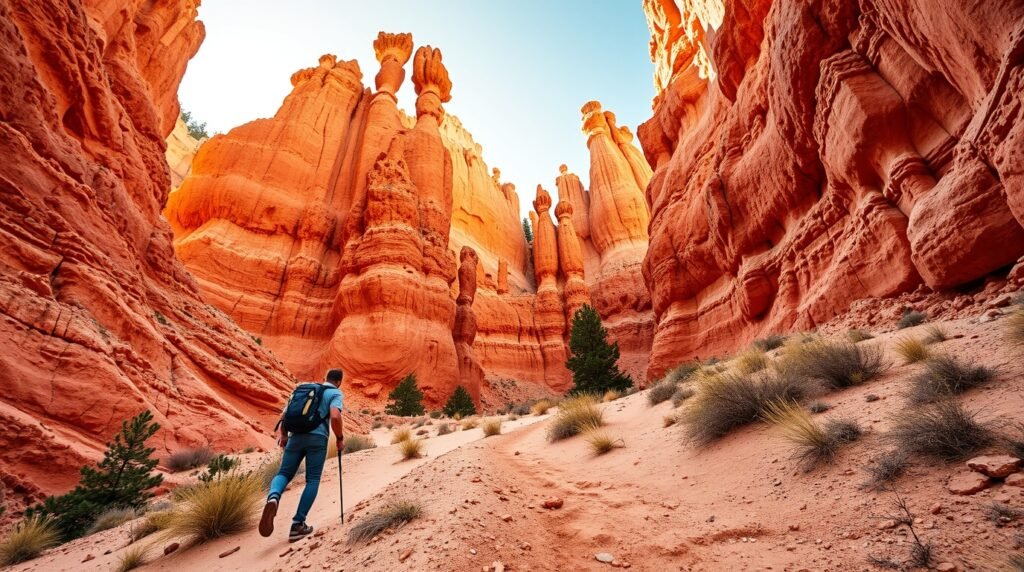
I recommend several trails that showcase the park’s unique landscape. The Queens Garden Trail is a favorite of mine for its easy access and beautiful views, especially for first-time visitors. It’s about 1.8 miles round trip.
The Navajo Loop is another iconic trail. It’s steeper but rewards hikers with incredible views of the hoodoos. The trail is roughly 1.3 miles and blends well with the Queens Garden Trail for a longer hike.
For a bit more challenge, the Fairyland Loop Trail is about 8 miles long. It offers breathtaking views of the amphitheaters. The Mossy Cave Trail is shorter at just 0.8 miles, allowing visitors to see a waterfall and unique rock formations.
The Rim Trail is another excellent option. This longer trail runs along the canyon’s rim and features several overlooks. I love taking my time on this trail, enjoying stunning views at multiple viewpoints.
Scenic Drives and Overlooks
The Scenic Drive is a relaxing way to see the park. Stretching about 18 miles, it takes you past many of the main viewpoints. I recommend stopping at Inspiration Point and Rainbow Point for breathtaking panoramas.
Each viewpoint offers a different perspective of the park’s unique landscape. Sunrise Point is ideal for early risers, while Sunset Point provides amazing evening views.
I also found using a GPS audio guide helpful. It enhanced my understanding of the park’s history and features as I toured the scenic drives and stopped at overlooks.
Adventure and Recreational Activities
For those seeking adventure, Bryce Canyon offers various activities. I enjoyed mountain biking on designated trails, where the changing scenery kept me engaged.
Horseback riding is also a unique way to explore the park. It provides a different perspective compared to hiking.
Stargazing is another great activity here. Bryce Canyon is a Dark Sky Park, meaning it has minimal light pollution. On clear nights, the sky fills with stars, making it perfect for night sky photography and simply enjoying the universe.
Bryce Canyon's Unique Ecology
Bryce Canyon National Park boasts a rich and diverse ecosystem. The combination of unique geological formations and varied climate creates habitats for many species of plants and animals. I find the detailed study of both flora and fauna fascinating, along with the park’s varied climate and weather patterns.
Flora and Fauna
The park features several distinct plant communities, including ponderosa pine forests, spruce-fir forests, and pinyon-juniper woodlands. Each area supports different wildlife. For instance, I often see deer, squirrels, and various bird species as I explore the park.
Additionally, the bristlecone pine, known for its ancient age and resilience, can also be found here. This tree can live for thousands of years, making it one of the oldest living organisms on Earth. The diversity of habitats means that over 100 bird species and many mammals thrive in this environment.
Climate and Weather Patterns
Bryce Canyon’s climate can be categorized into three distinct zones due to its elevation changes. The temperatures can vary greatly from day to night.
In winter, I’ll notice significant snowpack in the higher elevations, which helps sustain water sources during dry months. Summers tend to be warm and dry, while fall and spring can bring sudden weather changes. This variation supports the park’s unique ecology. Observing these shifts gives me a deeper appreciation for how weather patterns shape the environment and influence animal behavior.
Photography at Bryce Canyon
Bryce Canyon National Park offers stunning views for photographers. The unique rock formations, known as hoodoos, and the vibrant colors create picturesque scenes. Lighting is key for capturing the beauty of this park, especially during specific times of day.
Sunrise and Sunset Spots
I find that sunrise at Sunrise Point is among the best opportunities for breathtaking photographs. The early morning sun casts warm hues on the hoodoos, making the colors pop. Arriving before dawn allows time to set up and capture the changing light.
Another great spot is Sunset Point, where the canyon transforms under the evening sky. The light can create unique shadows, enhancing the details of the rock formations. I recommend staying for at least an hour to catch the full range of twilight colors.
Photographing the Night Sky
Bryce Canyon is renowned for its dark skies, making it a prime location for astrophotography. On clear nights, the stars shine brightly against the backdrop of the canyon. I suggest bringing a tripod and a wide-angle lens to capture the Milky Way.
In addition to stargazing, the moonlit landscape can create dramatic images. Photographing during a full moon can highlight the details of the hoodoos while still allowing you to see the stars. Be prepared for chilly temperatures at night, so dress warmly.
Tour Options From Las Vegas
- Bryce Canyon and Zion National Parks Day Tour
This full-day tour departs from Las Vegas and takes you to both Bryce Canyon and Zion National Parks. You’ll experience the unique landscapes of each park, with stops at key viewpoints and visitor centers. The tour includes round-trip transportation, park entrance fees, and lunch. It’s a great way to see two stunning parks in a single day.
Book here 3-Day Grand Canyon, Bryce, Zion, Antelope Canyon, and Monument Valley Tour
For a more immersive experience, this three-day tour covers multiple national parks and landmarks, including Bryce Canyon, Zion, the Grand Canyon, Antelope Canyon, and Monument Valley. The package includes transportation, accommodations, and guided tours at each location. It’s ideal for travelers looking to explore several natural wonders in one trip.
Book hereBryce Canyon Day Tour with Zion
This guided sightseeing tour offers a flight from the Las Vegas area directly to Bryce Canyon, flying over Zion National Park en route. Upon arrival, you’ll have the day to explore Bryce Canyon’s stunning landscapes before returning in the afternoon. This option provides a unique aerial perspective of the parks and maximizes your time on the ground.
Book here
Each of these tours offers a unique experience, catering to different interests and time constraints. Be sure to check the latest availability and details with the tour providers before booking.
Tips for Visitors

When visiting Bryce Canyon National Park, planning ahead is essential to make the most of your trip. I found that knowing the best times to visit, where to stay, and important safety tips can enhance my experience significantly.
When to Visit
I recommend visiting Bryce Canyon during the spring or fall for milder temperatures. Summer can be busy, with higher visitor numbers, but the longer days allow more time for exploration.
Winter is also beautiful, as the snow adds a unique contrast to the famous hoodoos. The park is less crowded at this time, and the views can be breathtaking. Remember to check the park’s schedule, as the Visitor Center has different hours depending on the season.
Parking At The Park
Parking at Bryce Canyon National Park can be limited, especially during peak season from April to October. The park offers several parking areas, but due to high visitor traffic, it’s important to plan ahead to avoid congestion.
Main Parking Areas
- Visitor Center Parking – A large lot near the entrance, ideal for getting information, maps, and using restrooms before heading deeper into the park.
- Sunset Point Parking – One of the most popular spots, often filling up quickly due to its proximity to major viewpoints and trailheads.
- Bryce Canyon Lodge Parking – Reserved primarily for lodge guests, but day visitors can park here briefly while exploring nearby trails.
- Inspiration Point Parking – Smaller lot but provides access to one of the best panoramic views of the park.
- Bryce Point Parking – Limited spaces but offers stunning views and access to hiking trails.
- Rainbow Point Parking – Located at the end of the scenic drive, this lot has more availability due to its distance from the main amphitheater.
Shuttle System & Alternative Parking
To ease congestion, the Bryce Canyon Shuttle operates from April to mid-October. Visitors can park for free at Ruby’s Inn & Bryce Canyon Shuttle Station outside the park and take the shuttle to various stops within Bryce Canyon. This is highly recommended, as it allows for stress-free exploration without worrying about parking availability.
Parking Tips
- Arrive early in the morning to secure a spot, especially at popular viewpoints like Sunset and Sunrise Points.
- Use the shuttle service to avoid parking struggles and reduce vehicle traffic in the park.
- Consider parking at less crowded areas like Bryce Point or Rainbow Point and hiking or shuttling to main attractions.
- Be aware of RV and oversized vehicle restrictions, as some lots may have limited space for larger vehicles.
Planning ahead and using the shuttle system can make parking much easier, allowing more time to enjoy the stunning landscapes of Bryce Canyon.
Accommodations and Facilities
I traveled to Bryce Canyon by charter bus, which made the trip convenient and stress-free. Without the need to worry about parking or navigating the roads, I could sit back and enjoy the scenic drive leading to the park. The journey itself was a great introduction to the region’s natural beauty, with vast plateaus, rugged rock formations, and glimpses of the surrounding national forests along the way.
Since I did not stay overnight, I planned my visit carefully to make the most of my time in the park. Upon arrival, I stopped at the Visitor Center to pick up a map and get information from the park rangers. The center had useful exhibits about the geology, wildlife, and history of Bryce Canyon, which helped me understand the unique landscape before heading out to explore.
With only a day to take in the sights, I focused on visiting the most iconic viewpoints and trails. The scenic drive through the park made it easy to reach several stunning overlooks, each offering a different perspective of the vast canyon and its famous hoodoos. Inspiration Point and Bryce Point were among my favorites, with breathtaking panoramic views of the amphitheater below. The way the sunlight shifted across the rock formations throughout the day created a constantly changing display of colors.
To maximize my experience, I used a GPS audio guide, which provided interesting facts and background information as I moved from one viewpoint to another. This self-guided approach allowed me to explore at my own pace while learning about the geological forces that shaped the landscape.
Even without an overnight stay, my visit to Bryce Canyon was unforgettable. The well-maintained facilities, easy access to viewpoints, and availability of helpful resources made it possible to experience the park’s beauty in just a single day. While I only scratched the surface of what Bryce Canyon has to offer, the visit left a lasting impression, and I hope to return in the future for a longer, more in-depth adventure.
Safety and Navigation
To stay safe, always stick to marked trails and follow park rules. The terrain can be steep and uneven, so wearing sturdy shoes is crucial.
I found it helpful to have a map and a GPS on hand, as cell service can be spotty. Hydration is key while hiking, so I always carried enough water. In case of emergencies, familiarize yourself with the park’s procedures and locations of rangers.
Comparative Analysis
Bryce Canyon National Park stands out among national parks in terms of its unique formations and accessibility. I find it helpful to compare it directly with other well-known parks like the Grand Canyon to understand its distinct features.
Bryce Canyon Vs. Other National Parks
When I think about Bryce Canyon and how it compares to other national parks, several key aspects come to mind. Unlike the Grand Canyon, which is famous for its vastness and deep gorges, Bryce Canyon is known for its beautiful hoodoos, which are tall, thin spires of rock that create a unique landscape.
Bryce Canyon is more compact, making it easier to explore in a shorter amount of time. I can hike the main trails and see several viewpoints in just one or two days. In contrast, the Grand Canyon often requires more time due to its larger size and more extensive trail system.
Many parks experience high visitor numbers, but Bryce Canyon, while popular, sees about half the number of visitors compared to the Grand Canyon. This means it’s often less crowded, allowing for a more intimate experience with nature.
Unique Highlights of Bryce Canyon
Bryce Canyon has several unique highlights that set it apart from other parks. The scenic drive in Bryce is 18 miles long and offers numerous overlooks with breathtaking views of the canyon rim. Each viewpoint presents a different perspective of the hoodoos and surrounding landscapes.
One of my favorite activities is hiking the Navajo Loop Trail, which takes you down among the hoodoos for a stunning close-up view. The contrast of red rocks against the blue sky is truly spectacular.
Another highlight is the park’s dark skies, making it ideal for stargazing. I’ve spent many nights quietly watching the stars shimmer brightly above, which enhances my appreciation for the park’s natural beauty. These features make Bryce Canyon a memorable place to visit.
Frequently Asked Questions
Is Bryce Canyon National Park open year-round?
Yes, the park is open 24 hours a day, 365 days a year, regardless of the season. However, some roads or trails may close temporarily due to weather conditions.Do I need a reservation to enter Bryce Canyon?
No, reservations are not required for park entry. Visitors can drive in and pay the entrance fee at the gate or use a valid park pass.What are the best viewpoints for sunrise and sunset?
Sunrise Point and Bryce Point are the top choices for watching the sunrise, as they offer panoramic views of the hoodoos bathed in golden light. Sunset Point and Inspiration Point provide breathtaking sunset views with deep orange and red hues across the landscape.What is the most popular hike in the park?
The Queen’s/Navajo Combination Loop is the most popular hike, offering an up-close experience with the hoodoos while descending into the canyon and passing famous formations like Thor’s Hammer.Is there a shuttle service, and is it mandatory?
The park provides a free shuttle service from April to mid-October, making it easy to access popular viewpoints and trailheads. The shuttle is optional but recommended to reduce congestion, especially during peak season.Are pets allowed in the park?
Pets are allowed only on paved surfaces, including designated sections of the Rim Trail and campgrounds. They are not permitted on dirt trails or inside buildings.When is the best time to visit Bryce Canyon?
The park is beautiful year-round, but late spring through early fall offers the most pleasant weather for hiking and sightseeing. Winter brings stunning snow-covered hoodoos and fewer crowds, making it a unique experience.What other attractions are nearby?
Bryce Canyon is close to several other national parks and scenic areas, including Zion National Park, Grand Staircase-Escalante National Monument, and Capitol Reef National Park, making it a great addition to a larger road trip.
Final Thoughts
My visit to Bryce Canyon National Park was nothing short of unforgettable. From the moment I arrived, I was captivated by the park’s breathtaking scenery, towering hoodoos, and vibrant colors that changed with the light throughout the day. Whether I was hiking the winding trails, standing at a scenic overlook, or simply taking in the vast expanse of the canyon, every moment felt like a step into a natural masterpiece sculpted by time.
Beyond its stunning landscapes, Bryce Canyon also left an impression with its diverse ecosystems, rich geological history, and commitment to conservation. The well-maintained trails, informative visitor center, and accessibility to various viewpoints made it easy to explore and appreciate the beauty of this unique national park.
For those planning a visit, I highly recommend taking time to hike at least one of the trails, as it offers a closer look at the hoodoos and the park’s ever-changing terrain. Whether it’s the iconic Navajo Loop, the scenic Queen’s Garden, or a leisurely walk along the Rim Trail, each path provides a unique perspective on Bryce Canyon’s natural wonders.
Bryce Canyon is a place that speaks to adventurers, nature lovers, photographers, and anyone seeking an awe-inspiring experience. It is a reminder of the incredible power of nature and the beauty that emerges through the forces of erosion and time. As I reflect on my journey, I know this will not be my last visit. The magic of Bryce Canyon is something that calls for a return, and I look forward to experiencing it all over again.
Gear I Use On My Trips
| Image | Product | Features | Price |
|---|---|---|---|
 | 9.5 | Check Price | |
 |
| 9.5 | Check Price |
My Top Action Camera  | 8 | Check Price | |
 | REEBOW GEAR Military Tactical Backpack Large Army 3 Day Assault Pack Molle Bag Backpacks… | 9.5 | Check Price |
 | 9.5 | Check Price |















